My Denali Prep course with AMS was both awesome and disappointing all at the same time. It was awesome because I was in Alaska for the first time, on the Kahiltna Glacier for 8 days, with “the tall one” standing right there. Our instructors were awesome too! Greg Runyan has an incredible amount of experience from 30 years of climbing throughout this Range, touching the top of Alaska 6 times with AMS since 2005. David Kerner is also well versed at tackling Denali with 4 successful summits of his own since 2019. Both offered many pro tips and tricks from their respective depths of knowledge.
What was disappointing about this Denali Prep Course was the missed opportunity to attempt a summit of Kahiltna Dome at 12,500 feet. I felt this to be a formidable peak in the Alaska Range that would have challenged my ability, refined my skills and better prepared me for a true Denali expedition.
Unfortunately, our band of Misfit Mountaineers came no where near meeting this course objective.
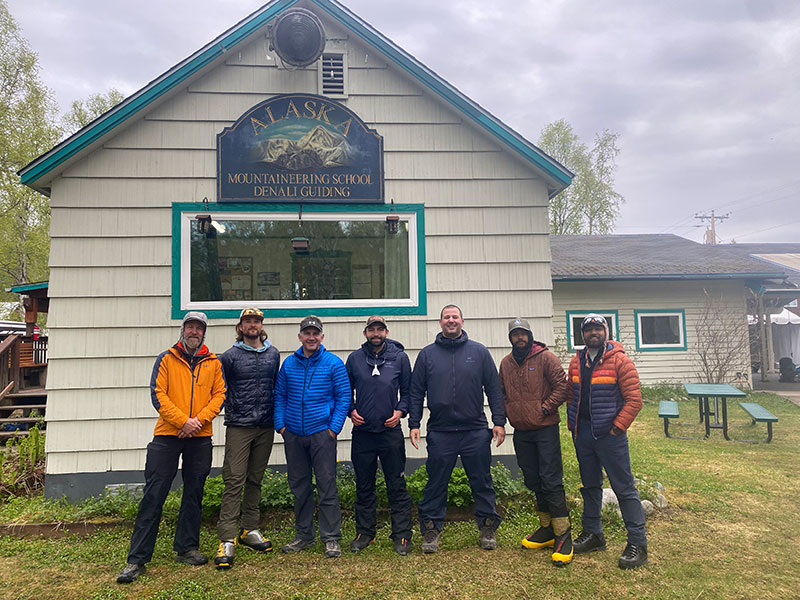
Setting Initial Expectations
The AMS Denali Prep Course, with a Kahiltna Dome objective, immediately sets your expectation that the experience is going to be tough… and it should be since the stated intent of this training is to “mirror a Denali climb” as described on their website:
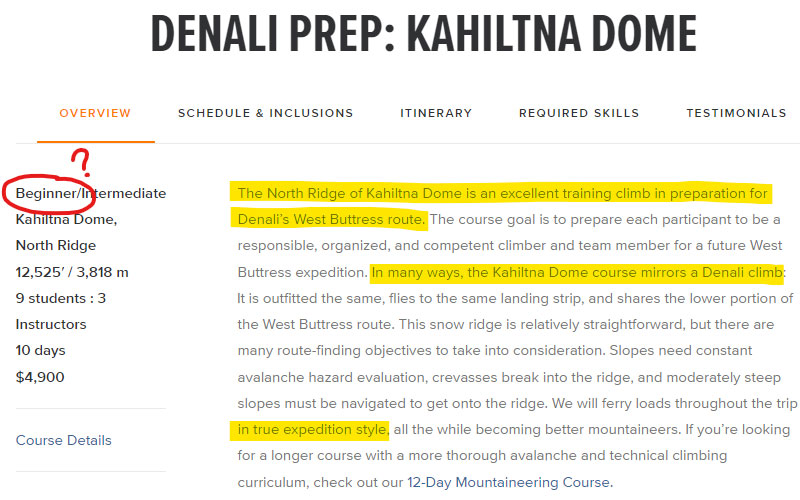
However, you will notice that the course is also listed as Beginner/Intermediate, rather than Intermediate/Advanced. How could that be? What defines a “beginner mountaineer”? Is it someone who has little to no mountaineering experience, or someone who has spent a decent amount of time on “beginner” peaks such as Shasta, Hood, Baker and even Mount Rainer? I consider myself a beginner/intermediate mountaineer but came with a lot more experience than just these few.
Maybe the red flag should have had something to do with not requiring any skills. In other words, no specific prerequisites other than excellent mental/physical condition and a strong desire to learn:

The first status update AMS HQ posted about us even reinforced the difficulty level to expect here:

Simulating “a full Denali expedition” is confirmation enough to make you think this is going to be hard, right? …but wait, there’s more! The itinerary also spells out how we will get above 10,000′ to camp:
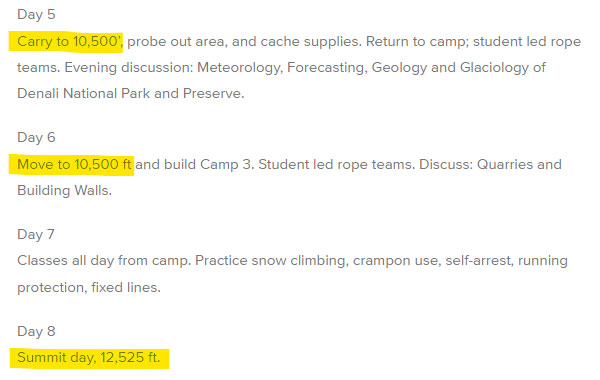
Help me do the math here. How does someone go from having no skills to summiting K-Dome?!
This just doesn’t add up after what we really experienced. I get it if we couldn’t attempt a summit for weather-related reasons, but that was definitely not the case here. The odds of this group reaching the Kahiltna Dome was increasingly slipping away, and that was obvious before we even left Talkeetna!
Beginner, Intermediate or Advanced
So is D-Prep for beginners? …an introduction to winter camping that covers novice stove use, outdoor cooking basics and cold weather management? Is it 101-level learning where you are taught how to put on snowshoes, hold an ice axe and tie basic knots for your very first time? That sounds more like the the AMS 6-Day Mountaineering Course to me:

The required skills are appropriately noted too: none!

This description here even does a better job encouraging participants to come with prior experience. Does that imply D-Prep is more beginner-focused than this actual beginner’s 6-Day course? Or should D-Prep be Intermediate, or dare I say, Advanced? …a 201-level refresher with a 301-level opportunity to refine and built upon knowledge and skills you already have?
Ready for Denali NOW
I definitely think it should be the later! I didn’t come all the way to ALASKA to learn Mountaineering 101. That could have been done somewhere much less expensive. I came to Alaska, and chose AMS specifically, because I wanted an experience that most closely resembled the real thing. Kahiltna Dome sounded like the right step to do before Denali. Taking D-Prep should mean you are ready for Denali NOW, not several years from now. Maybe I’m a unique case, where my plans got pushed out another year, but I just wanted to test my readiness by going through all the motions of a real Denali summit attempt without actually summitting.
Coincidentally, the group queued up directly in front of us at AMS HQ was a K-Dome Custom Climb. If this AMS Denali Prep course was serious about reaching K-Dome, we should have been capable of mimicking exactly what they did! Any extra days added to D-Prep would be for the educational element along the way. Speaking of which, I wonder what percentage of AMS D-Prep courses actually make it to K-Dome. If that percentage is low, why are you still promoting this as the target destination?
Was our course typical or was it an anomaly?
To be clear, this isn’t about not making K-Dome specifically. We could’ve done anything above 10K to have been given a better expedition-like experience! Obviously based on weather and terrain conditions, participants should be ready and able to reach Mt. Capps, 11k Camp, Motorcycle Hill or go as far as Windy Corner. The point here, especially since this course is located in Alaska, is to give us as much experience of the actual Denali route as possible. That is where this group fell so short.
The AMS Screening Process Failed
I would say the AMS screening process failed for this course. In my opinion, participants weren’t vetted enough… and that problem didn’t become ours until we got on the mountain and had to dumb everything down. Why didn’t someone contact us for a quick phone interview as part of the applicant review (or placement) process? I can tell you my acceptance was based on no further conversation about qualifications beyond these 4 short lines on my AMS application:
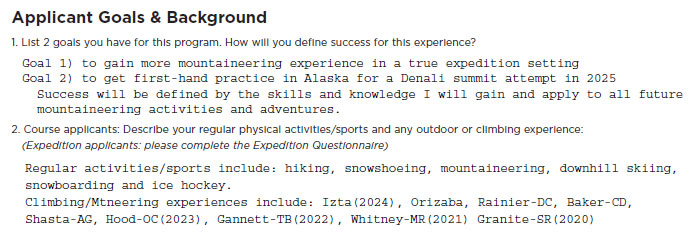
I heard the AMS co-founder, Colby Coombs, personally interviews every climber that signs up for their guided expeditions. If D-Prep is meant to mimic a real expedition, why not interview these participants in a similar fashion? It’s not like there would be hundreds of applicants to process.
Who Pays the Consequence
The consequence for poorly placed participants should be shared in my opinion. Qualified course participants can’t be the only ones to pay the price for getting a mediocre experience based on this low acceptance criteria. Did I get what I paid for based on the expectations set above? I think not.
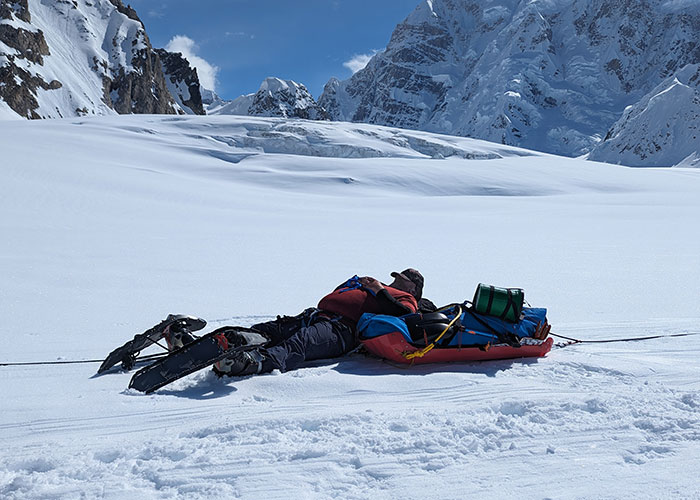
I know I fretted for months about not being fully capable. Last thing I wanted was to be “that guy” who held everyone back due to not being Denali-ready. Turns out I was the strongest with the most experience. So much so, that the instructors told me “you could have been our 3rd guide”. Appreciate the compliment, but my purpose here was not to provide a guide-level service.
My perceived value of this “Denali Prep” course in Alaska was even prioritized over an invite to Bolivia with my hiking friends over the same period of time. While I only reached a mere 9,300 feet, they successfully summited Illimani (21,122′), Huayna Potosi (19,974′), Pequeno Alpamayo (17,799′), Tarija (17,618′) and Pico Austria (17,480′). Back when we were planning our respective trips, that group leader kept telling me “Bolivia is good training for Denali, ya know”. Yeah, I should have listened to her.
Suggested Solutions
I still think AMS is the premier provider for learning in Alaska. However, there are a few things I would strongly consider changing with how they position their D-Prep Course:
Change The Objective
If D-Prep is meant for beginners, get rid of the K-Dome objective!
Instead, just call it DENALI PREP: KAHILTNA GLACIER
That way, you can travel as near or as far on the glacier as the instructors see fit and still meet the vague course objective. AMS can also save themselves the embarrassment of having such beginners trip over their snowshoes, get tangled up in the rope and fumble around in front of real expedition teams.
Require More Skills
If D-Prep is meant for intermediate to advanced, spell out some specific prerequisites. You said it yourself: “This course is designed to prepare students for a full Denali expedition”. That should mean you’re not ready for this level without extensive backpacking experience, working knowledge of mountaineering gear, knowing how to tie basic knots and a decent understanding of hauling systems.
AMS did send us the book, Glacier Mountaineering, to read as homework:
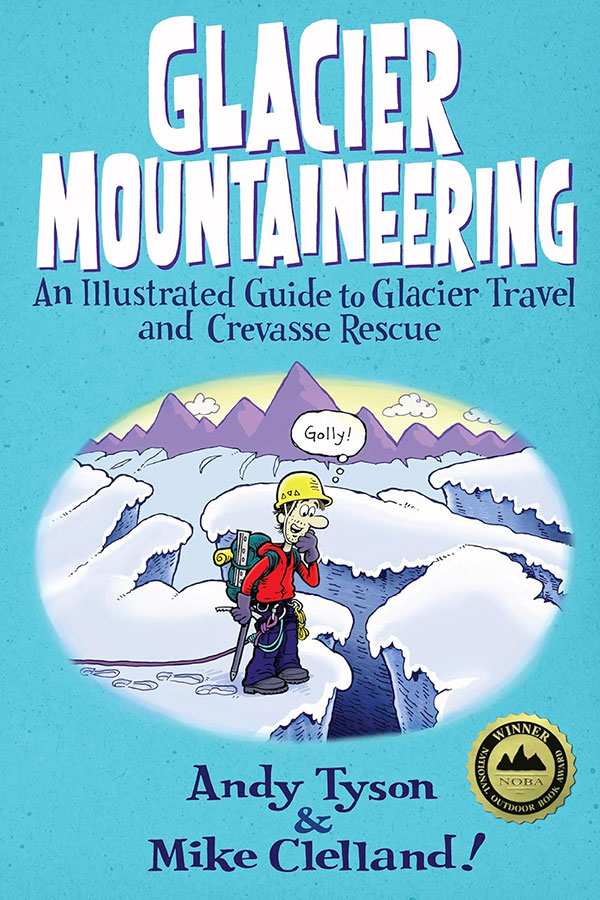
Of the five of us, how many do you think took the time to actually read it? One participant told us, “I don’t read books”. Another participant, a last-minute addition to this course, wouldn’t have had time. My tentmate brought it with him to read on rest days. This was homework people. Denali Prep is the mid-term exam! So I would consider participants not studying beforehand as another point of failure.
I just barely looked a the AMS application for Expeditions. THAT IS WHAT WE SHOULD HAVE BEEN REQUIRED TO COMPLETE!!!!!!! This is exactly what I’m talking about here! Those same questions, qualifications and previous experiences should be the filter for any Denali Prep course, AMS or other.
Maybe Next Time
If all this equates to not being ready for D-Prep, then you have some work to do! Look into local training opportunities. Plan more frequent trips with your friends. Work out your kinks before signing up for something as close to summiting Denali without summiting Denali. Get your homework done because your day on Denali will be like the final exam. That’s how I went into this AMS course.
I realize this course could have been cancelled based on not having enough qualified participants, but then I would have just gone to Bolivia and added 5 more peaks above 17,000′ to my climbing resume. Unfortunately, my decision to spend almost $8,000 to hike a mere 5.5 miles to Ski Hill, with an overall elevation gain of only 1,100 feet, severely missed the mark on what I thought I would get from D-Prep.
I expected this AMS course to be harder… a lot harder!
